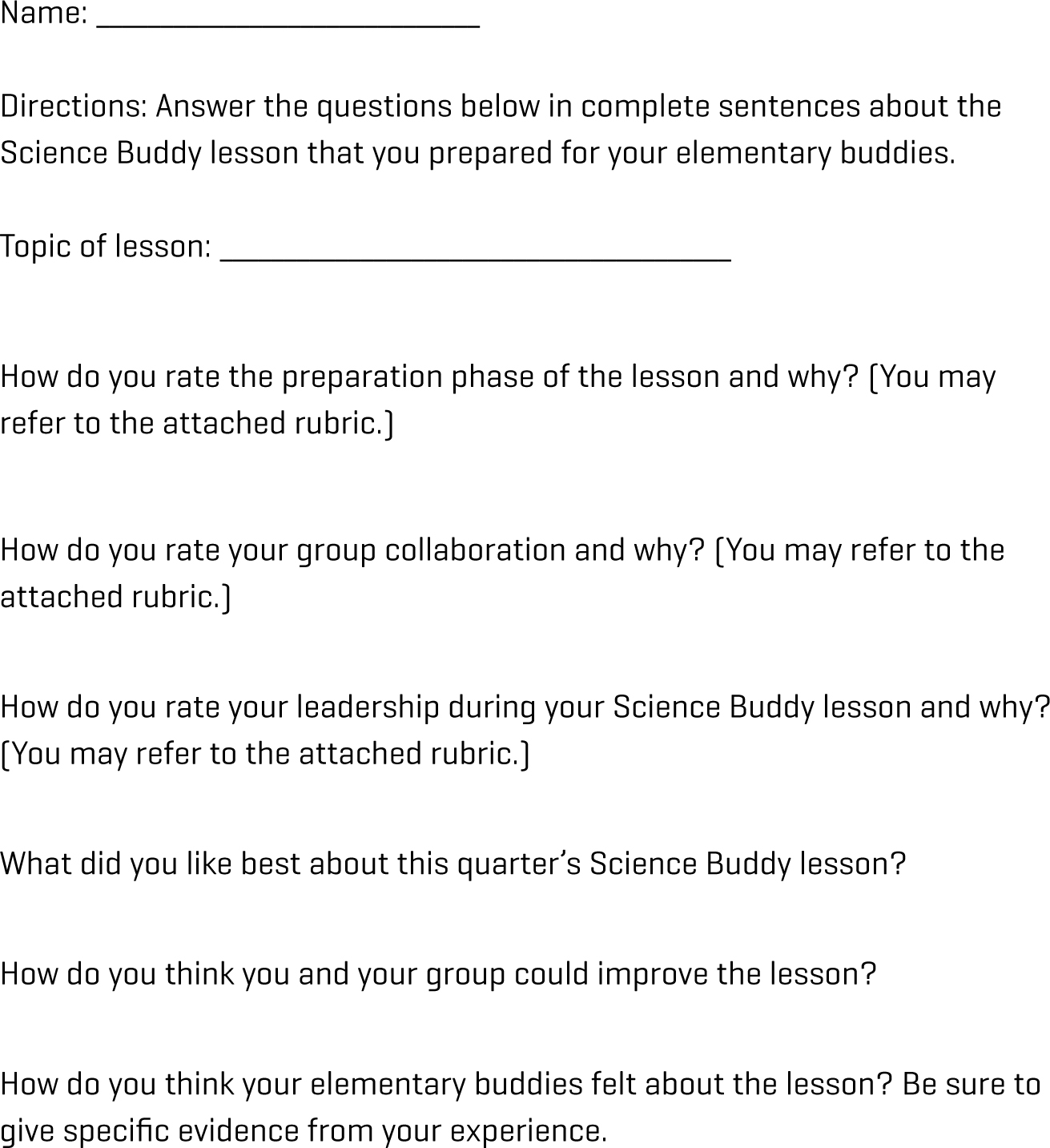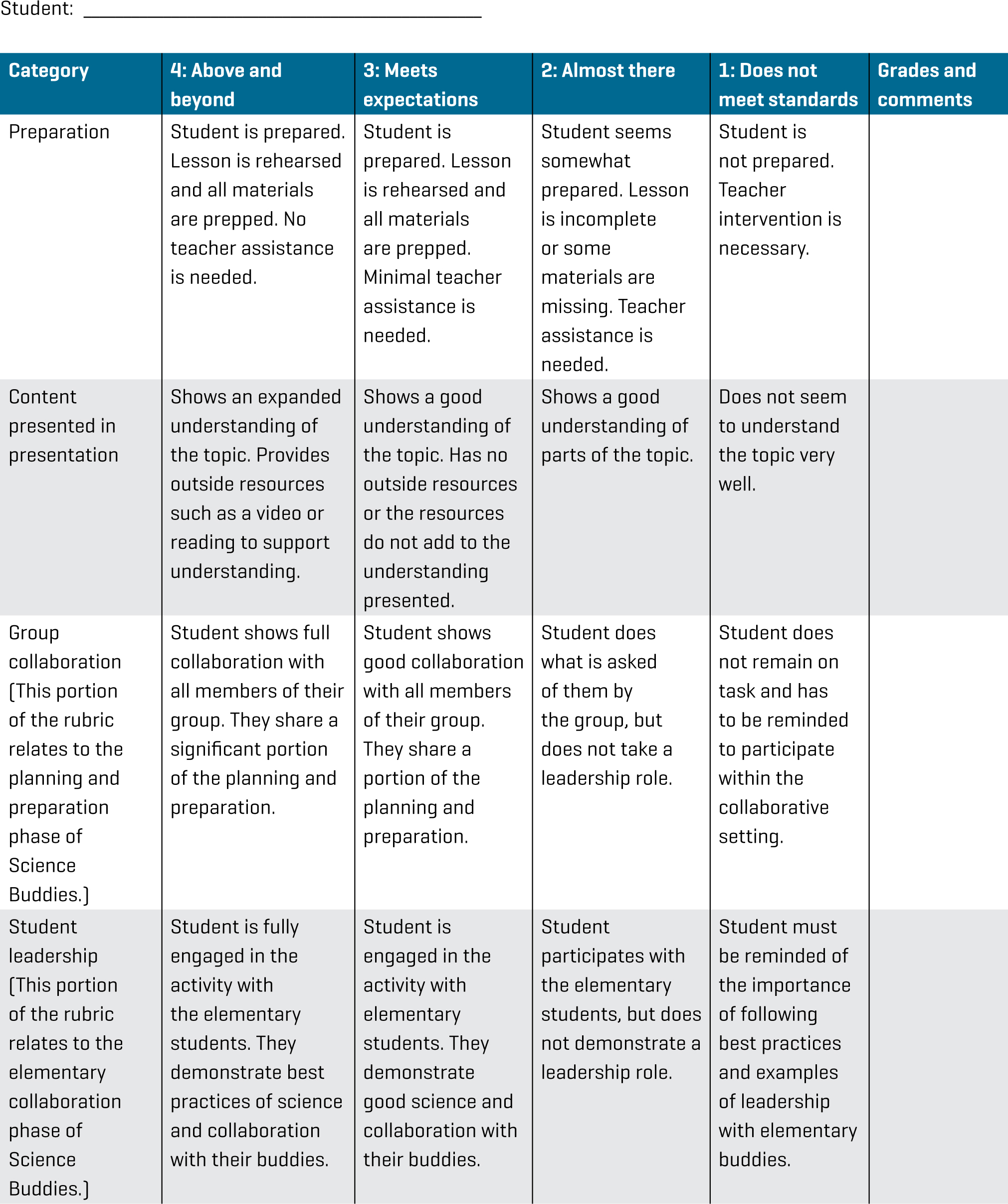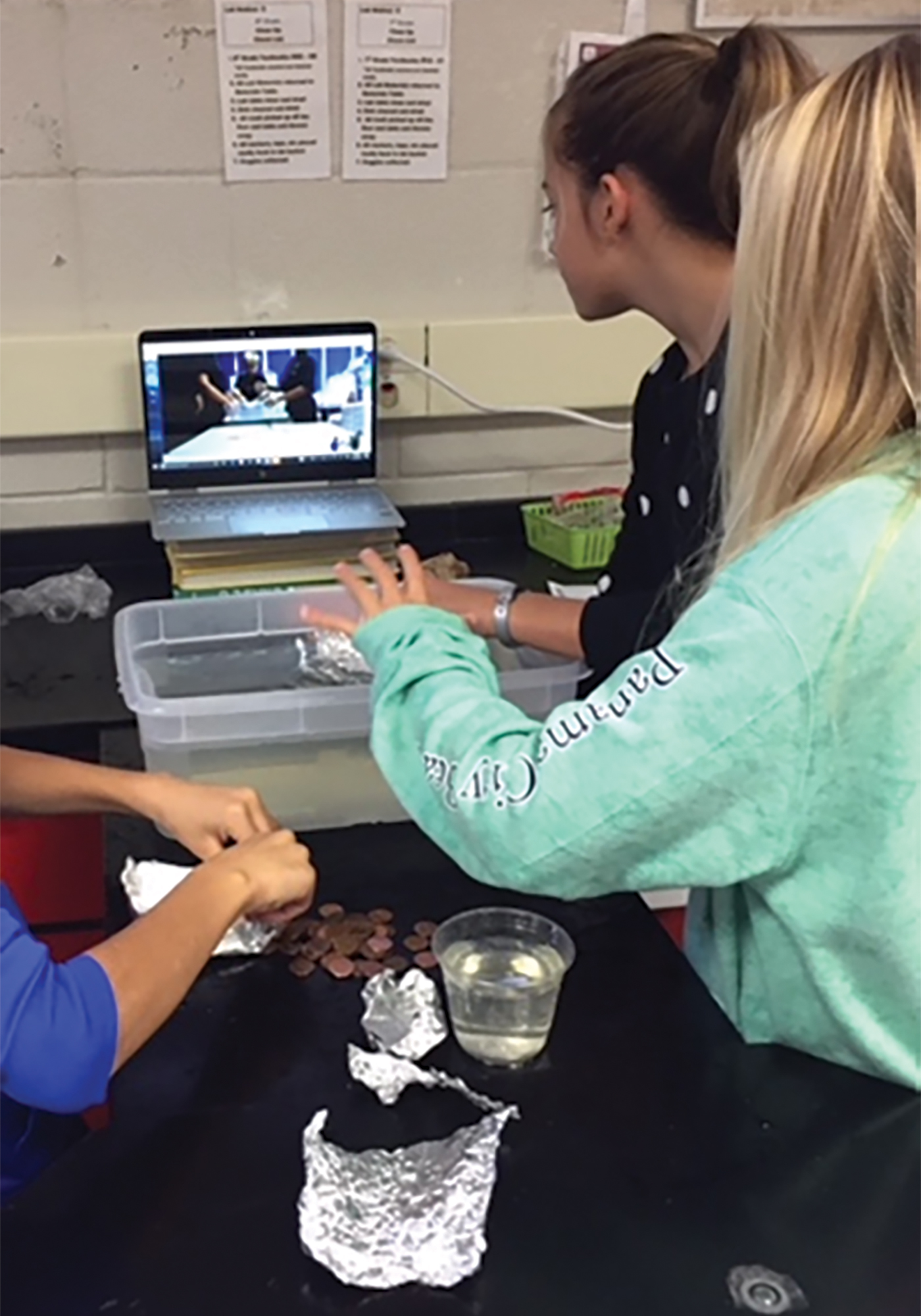Teacher's Toolkit
Science Buddies
By LINDA SMITH
How-to strategies and classroom management tips
How can teachers create opportunities for collaboration beyond their classroom walls? How can science teachers create meaningful opportunities for students to share and problem solve together beyond creative lab groupings? With these questions in mind and with an elementary teacher’s request to collaborate with her first graders in STEM, a middle school Science Buddies Program was born.
The opportunity presented itself when a first-grade teacher from my district contacted me about the possibility of partnering. I had taught her daughter a few years before and she knew I was always open to new and exciting ideas. Her plan was for one of my seventh-grade classes to teach a monthly or quarterly STEM lesson to her first-grade students. She thought her students would learn more if partnered with a science buddy. We decided the best way to organize the buddies was to partner a group of 26 elementary students with a group of 24 middle school students. Since the time available for teaching science in elementary school was limited, she wanted the lessons to be high quality. In order to ensure high-quality lessons, teachers provided feedback to students during the planning phases and reflections at the end of each lesson.
Prior to introducing Science Buddies to our students, both of us secured permissions for the middle school students to visit the elementary school and organized transportation. We spoke with our principals and explained the project idea. They enthusiastically agreed to the idea. Our school is fortunate to have minibuses available that we can use for school activities with no cost to students. I arranged for the middle school students to travel on the school minibus to the elementary school. Alternatively, we could have arranged for a city bus to pick up students.
Preparing for the activity
I shared the project idea with my middle school students and received enthusiastic approval. Due to only having one elementary class to partner with, I chose the one middle school class that had the most class time available. The class I selected happened to have lunch immediately after their science period, which gave us an extra 30 minutes for our trip. There were lots of questions: “Can first graders read?” “Do they know how to write?” We also spent a significant amount of time talking about the types of lessons they might develop. What would be appropriate for elementary students? How could we make sure they were learning? What are important science skills for younger students? To answer these questions, I gave the middle school students the first-grade science standards. They looked and planned for lessons that met the standards and could be completed in one class period.
Students began with researching topics on the internet. During the research phase of the activity, students were encouraged to think of topics they studied throughout the year and create lessons that would allow them to build on those understandings. In seventh grade, students study various physical science, Earth science, and life science concepts. They thought that young children might enjoy the physical science activities best. After researching and sharing lesson ideas, students chose their top three lesson ideas: Self-inflating balloons, Oobleck, and film canister rockets (see Resources).
Although students weren’t as concerned about the standards as we were, we spent time thinking about what they had learned in class that they could build on for their lesson. We discussed how the science they had learned could be addressed appropriately with elementary students. All students agreed that elementary students needed to have some understanding of matter in order to understand these lessons. This meant that the middle school students needed to convey ideas related to the states of matter, chemical and physical properties, and evidence of whether chemical reactions had occurred. This led to discussions related to science concepts that students had mastered previously. For example, students discussed Oobleck and whether it was a chemical reaction or just a change in state. They were excited to discover that they had made a non-Newtonian fluid. Students quickly decided that this wasn’t important for their buddies to understand, but it led to further investigations on their part about what was happening at the particle level. Similar conversations occurred during the film canister rockets and the self-inflating balloons activities, as students worked to understand the chemical reactions occurring between baking soda and vinegar (in the self-inflating balloons) and the effervescent antacid and water (in the film canister rockets).
Once the middle school students had a firm understanding of the content and the lesson ideas, they needed to plan out the specific activities they would do during the 30–40 minute class period with their elementary buddies. Students created a guide for their elementary students. Their guides had to include preteaching questions, observation questions, predictions, and final questions. When their plans were completed, they presented them to the teacher for approval. After receiving teacher approval, students presented their lessons to their middle school classmates. This gave teachers an opportunity to evaluate students’ content understanding and make any changes necessary prior to meeting with their buddies.
The middle school students worked with their assigned lab groups throughout the project. They had lab leaders, materials managers, safety managers, and clean-up managers, and they followed those roles with the elementary students. Elementary students were grouped by their classroom teacher prior to arrival, based on groups that would work best together. Each teacher knew the number of groups they would have and group numbers were matched during the visit. The groups consisted of three middle school students and three or four elementary students.
When presenting to their buddies, students engaged the younger students in science and engineering practices (SEP). For example, during the Oobleck activity, my students decided to focus on having the younger students make observations of the cornstarch and water. They then made predictions with the younger students as to what would happen when they mixed the materials together. After mixing the materials, my students encouraged their elementary buddies to predict what would happen if they placed different objects in the Oobleck. They also considered what might happen if they added more or less water to the cornstarch or more cornstarch to the mixture. The middle school students encouraged their buddies to observe, predict, experiment, and observe again, reinforcing the SEP of planning and carrying out investigations.
All of the participant teachers spent time before beginning the project to establish the expectations for both the project and students. For the elementary students, this involved following all classroom rules, including proper behavior with guests. For the middle school students, this involved following all classroom rules. Additionally, students were encouraged to take very seriously their roles as mentors and to behave in such a way that would encourage positive behavior with their elementary buddies. Middle school Science Buddies seemed to almost magically transform into “mini-teachers,” guiding their elementary buddies and keeping them on track.
Expanding the impact of Science Buddies with technology
The middle school students only had one complaint after the first year of the Science Buddies Program. Why could only one science class participate? Their question indicated they liked being a Science Buddy and wanted to continue in future years. The problem was logistics; scheduling only worked for one seventh-grade class in our school setting.
It was at this point that we decided to put technology to use. Our schools are 1:1 with iPads. One-to-one means that each student is given a device (iPad, Chromebook, or laptop) to use during the school day and often to take home with them after school. I wanted to find other teachers who were willing to create a Virtual Science Buddies Program. Participating teachers needed to be in a 1:1 school. I found two elementary teachers who met that requirement at the parochial school across town. One of the teachers was my daughter and the other was a colleague of hers.
The logistics of transportation and school schedules was replaced with concerns over filters, bandwidth, and connectivity. The lead teacher from the parochial school and I spent a significant number of hours working to get filter requirements changed and connections to work. School networks and filters will determine what types of collaboration software you can use. We used Google Hangouts for our collaboration, but Skype or FaceTime (between iPad users) would have worked as well.
Despite all the frontloading to prepare for the potential technology glitches, the first virtual “getting to know you” session was challenging. Once connected, students had trouble hearing their partners. With the assistance of each school’s IT department, the technology eventually worked, and the middle school students were able to meet their elementary science buddies virtually for the first time. By adapting the program for virtual meetings, we were able to take a program involving only 23 students and expand it to include 120 middle school students and over 80 elementary students spread among five middle school classrooms and three elementary classrooms housed in three different schools.
Assessment
The assessments for this program included three components. We assessed the elementary students’ use of inquiry skills, including student predictions, observations (drawings and written), and reflections. The middle school students’ assessment included a Science Buddies self-assessment (Figure 1) and a rubric that evaluated their Science Buddies lesson (Figure 2).


The rubric components were chosen to help students focus on the important skills involved in the project. Preparation and understanding of content are necessary for educational mentoring. Additionally, collaboration and leadership are 21st-century skills, which must be developed for all science learners. All the teachers agreed that the most important component to assess was that of student engagement relating to the collaboration. Therefore, the informal assessments and reactions throughout the process were as significant to the program’s success as were the summative assessments.
Conclusion
Even the most difficult-to- motivate students seemed to find some form of buy-in with the Science Buddies Program. For some students, it was having the opportunity to “be in charge.” For others, it was “getting to work with cute little kids” (Figure 3). Many students were also motivated by the opportunity to use technology in an authentic manner. Every middle school student shared in their reflection statements that they learned more by teaching because they needed to understand the concepts prior to teaching them. The elementary teachers shared that their students were equally as excited and motivated by the Science Buddies Program.

When asked whether the program helped improve interest for their students in science, a teacher shared, “Definitely! My students have been asking about more science topics and wondering what different things they can do with science when they are older.”
Now that Science Buddies has gone virtual, most of the participating teachers are interested in trying to partner with other schools outside their state or even the country. The motivation for a global reach returns us to our original goal of engaging students. Science Buddies has opened our middle school students to others, and although they are local, they differ in age, area, and background. As teachers, we wonder, how much could we open the world to our students by extending our virtual reach to partner with students elsewhere? What would STEM lessons and problem-solving look like with elementary students in Brazil? There is no limit to the potential for Science Buddies, and we are just beginning to scratch the surface.


